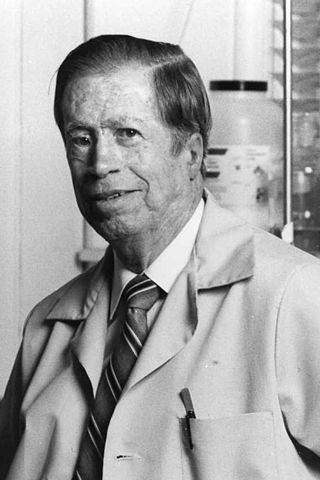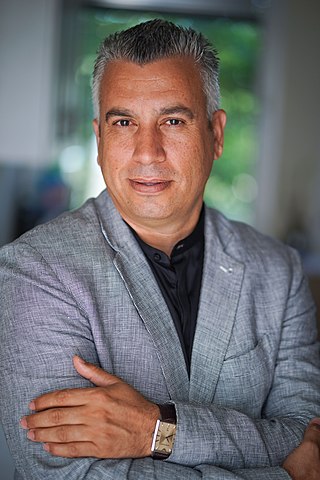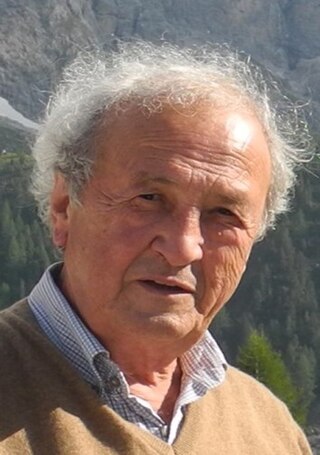Related Research Articles

Hermann Emil Louis Fischer was a German chemist and 1902 recipient of the Nobel Prize in Chemistry. He discovered the Fischer esterification. He also developed the Fischer projection, a symbolic way of drawing asymmetric carbon atoms. He also hypothesized lock and key mechanism of enzyme action. He never used his first given name, and was known throughout his life simply as Emil Fischer.
Native Chemical Ligation (NCL) is an important extension of the chemical ligation concept for constructing a larger polypeptide chain by the covalent condensation of two or more unprotected peptides segments. Native chemical ligation is the most effective method for synthesizing native or modified proteins of typical size.

Robert Bruce Merrifield was an American biochemist who won the Nobel Prize in Chemistry in 1984 for the invention of solid phase peptide synthesis.

In organic chemistry, peptide synthesis is the production of peptides, compounds where multiple amino acids are linked via amide bonds, also known as peptide bonds. Peptides are chemically synthesized by the condensation reaction of the carboxyl group of one amino acid to the amino group of another. Protecting group strategies are usually necessary to prevent undesirable side reactions with the various amino acid side chains. Chemical peptide synthesis most commonly starts at the carboxyl end of the peptide (C-terminus), and proceeds toward the amino-terminus (N-terminus). Protein biosynthesis in living organisms occurs in the opposite direction.
Chemical biology is a scientific discipline between the fields of chemistry and biology. The discipline involves the application of chemical techniques, analysis, and often small molecules produced through synthetic chemistry, to the study and manipulation of biological systems. In contrast to biochemistry, which involves the study of the chemistry of biomolecules and regulation of biochemical pathways within and between cells, chemical biology deals with chemistry applied to biology.

Biocatalysis refers to the use of living (biological) systems or their parts to speed up (catalyze) chemical reactions. In biocatalytic processes, natural catalysts, such as enzymes, perform chemical transformations on organic compounds. Both enzymes that have been more or less isolated and enzymes still residing inside living cells are employed for this task. Modern biotechnology, specifically directed evolution, has made the production of modified or non-natural enzymes possible. This has enabled the development of enzymes that can catalyze novel small molecule transformations that may be difficult or impossible using classical synthetic organic chemistry. Utilizing natural or modified enzymes to perform organic synthesis is termed chemoenzymatic synthesis; the reactions performed by the enzyme are classified as chemoenzymatic reactions.
Chemical ligation is the chemoselective condensation of unprotected peptide segments enabled by the formation of a non-native bond at the ligation site.

Ronald T. Raines is an American chemical biologist. He is the Roger and Georges Firmenich Professor of Natural Products Chemistry at the Massachusetts Institute of Technology. He is known for using ideas and methods of physical organic chemistry to solve important problems in biology.
Joseph Stewart Fruton, born Joseph Fruchtgarten, was a Polish-American biochemist and historian of science. His most significant scientific work involved synthetic peptides and their interactions with proteases; with his wife Sofia Simmonds he also published an influential textbook, General Biochemistry. From 1970 until his death, Fruton worked extensively on the history of science, particularly the history of biochemistry and molecular biology.
Richard A. Houghten is a heterocyclic organic chemist and founder of the journal Peptide Research, which was later merged with the International Journal of Peptide and Protein Research, to become the Journal of Peptide Research. His work mainly concerns peptide activity and pharmacology. He is the founder and president of the Torrey Pines Institute for Molecular Studies (TPIMS), a biomedical research institute. Houghten pioneered the "tea-bag" approach of producing peptides for pharmacological work.

Racemic crystallography is a technique used in structural biology where crystals of a protein molecule are developed from an equimolar mixture of an L-protein molecule of natural chirality and its D-protein mirror image. L-protein molecules consist of 'left-handed' L-amino acids and the achiral amino acid glycine, whereas the mirror image D-protein molecules consist of 'right-handed' D-amino acids and glycine. Typically, both the L-protein and the D-protein are prepared by total chemical synthesis.

Morten Peter Meldal is a Danish chemist and Nobel laureate. He is a professor of chemistry at the University of Copenhagen in Copenhagen, Denmark. He is best known for developing the CuAAC-click reaction, concurrently with but independent of Valery V. Fokin and K. Barry Sharpless.
Ralph Franz Hirschmann was a German American chemist who led a team that was responsible for the first organic synthesis of an enzyme, a ribonuclease.

Klaus H. Hofmann was an American biological chemist and medical researcher. The New York Times called Hofmann an "expert on synthesis of body compounds". His career was highlighted by synthesis of a prototype birth control pill, isolation and structural characterization of biotin, determination of the lysine specificity of the pancreatic protease trypsin, the first chemical synthesis of a fully biologically-active portion of the peptide hormone, and structure-function studies on ribonuclease (RNase).
George Wallace Kenner FRS was a British organic chemist. He was born in Sheffield in 1922, the son of Prof. James Kenner. During his childhood, he went to Didsbury Preparatory School in 1928 and moved to Manchester Grammar School in 1934. He was appointed to the first Heath Harrison Chair of Organic Chemistry at the University of Liverpool 1957–1976. He did his MSc and PhD degrees under Lord Todd at Manchester and Cambridge Universities in UK. He married Jillian Bird in 1951 and they had two daughters both born in Cambridge. He was faculty member at the Cambridge University for 15 years before moving to the University of Liverpool in 1957 as Heath Harrison Professor of Organic Chemistry.
Bradley Lether Pentelute is currently a professor of chemistry at the Massachusetts Institute of Technology (MIT). His research program lies at the intersection of chemistry and biology and develops bioconjugation strategies, cytosolic delivery platforms, and rapid flow synthesis technologies to optimize the production, achieve site-specific modification, enhance stability, and modulate function of a variety of bioactive agents. His laboratory successfully modified proteins via cysteine-containing “pi-clamps” made up of a short sequence of amino acids, and delivered large biomolecules, such as various proteins and drugs, into cells via the anthrax delivery vehicle. Pentelute has also made several key contributions to automated synthesis technologies in flow. These advances includes the invention of the world's fastest polypeptide synthesizer. This system is able to form amide bonds at a more efficient rate than standard commercial equipment and has helped in the process of understanding protein folding and its mechanisms. This automated flow technology was recently used to achieve total chemical synthesis of protein chains up to 164 amino acids in length that retained the structure and function of native variants obtained by recombinant expression. The primary goal of his endeavor is to use these processes to create designer biologics that can be used to treat diseases and solve the manufacturing problem for on-demand personalized therapies, such as cancer vaccines.
Synthetic biopolymers are human-made copies of biopolymers obtained by abiotic chemical routes. Synthetic biopolymer of different chemical nature have been obtained, including polysaccharides, glycoproteins, peptides and proteins, polyhydroxoalkanoates, polyisoprenes.

ᴅ-Amino acids are amino acids where the stereogenic carbon alpha to the amino group has the ᴅ-configuration. For most naturally-occurring amino acids, this carbon has the ʟ-configuration. ᴅ-Amino acids are occasionally found in nature as residues in proteins. They are formed from ribosomally-derived ᴅ-amino acid residues.

Ashraf Brik is a full professor at the Schulich Faculty of Chemistry at the Technion Institute of Technology, Israel. His laboratory specializes in developing synthetic methods for chemical synthesis of proteins with post-translational modifications (PTMs) in quantities that allow for them to be studied thoroughly. Brik's group is developing novel modulators based on small molecules, peptides and peptidomimetics, to influence enzymes and proteins involved in various diseases. With the help of these tools, it is possible to understand how molecules and biological systems affect health.

Luis Moroder is an Italian peptide chemist, who pioneered research on the interactions between peptide hormones and cell membrane-bound hormone receptors. He later expanded this research to other biological systems of medical relevance such as protein inhibitors, collagens, and synthetic proteins. A hallmark of his research is interdisciplinarity as reflected in his use and development of methods in organic chemistry, biophysics and molecular biology. He is a co-editor of the five-volume Houben-Weyl, Methods of Organic Chemistry, Synthesis of Peptides and Peptidomimetics. Since 2008 he is the editor-in-chief of the Journal of Peptide Science, the official journal of the European Peptide Society.
References
- ↑ Constructing proteins by dovetailing unprotected synthetic peptides: backbone engineered HIV protease. M. Schnölzer, S.B.H. Kent Science, 256, 221-225 (1992).
- 1 2 Moroder, Luis; Diederichsen, Ulf (May 2016). "Editorial: A Tribute to Stephen B. H. Kent: Towards a new world of proteins enabled by chemical synthesis". Journal of Peptide Science. 22 (5): 245. doi:10.1002/psc.2892. PMID 27160918. S2CID 206421504.
- ↑ Synthesis of native proteins by chemical ligation. Dawson PE, Kent SB. Annu Rev Biochem. 2000;69:923-60.
- ↑ Total chemical synthesis of a D-enzyme: the enantiomers of HIV-1 protease show reciprocal chiral substrate specificity [corrected]. Milton RC, Milton SC, Kent SB. Science. 1992 Jun 5;256(5062):1445-8
- ↑ X-ray structure of snow flea antifreeze protein determined by racemic crystallization of synthetic protein enantiomers. Brad L. Pentelute, Zachary P. Gates, Valentina Tereshko, Jennifer Dashnau, Jane M. Vanderkooi, Anthony A. Kossiakoff, Stephen B. H. Kent, J Am Chem Soc, 130, 9695-9701 (2008); Chemical synthesis and X-ray structure of a heterochiral {D-protein antagonist plus vascular endothelial growth factor} protein complex by racemic crystallography. Mandal K, Uppalapati M, Ault-Riché D, Kenney J, Lowitz J, Sidhu SS, Kent SB. Proc Natl Acad Sci U S A. 2012 Sep 11;109(37):14779-84.
- ↑ Kent, Stephen (1970). Peptide sequences by mass spectrometry (Masters thesis). Massey Research Online, Massey University. hdl:10179/11100.